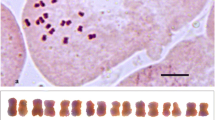Summary
Pachytene chromosome morphology was compared in nine races ofRicinus communis L. (2n = 20), using pollen mother cells (PMCs) and light microscopy. Of the ten bivalents, only the two possessing nucleolar organizing regions (NORs), chromosomes 2 and 7, exhibit structural variations among the races. The NORs are located in the short arms of these two chromosomes. Most of the observed structural variations affect these short arms, which are similar morphologically and consist largely of heterochromatic segments. The PMCs contain a single nucleolus and this is associated with the NOR of each of the two chromosomes at a particular frequency in each race. In eight races, a nucleolar constriction (NC) is present in either chromosome 2 or chromosome 7. In these races, the nucleolus is associated with the chromosome possessing an NC at a frequency of 100% and with the chromosome lacking an NC at a frequency ranging between 5.6 and 100%, depending upon the race. No microscopically visible NC is present in the ninth race. In this race, the nucleolus is associated with both chromosomes 2 and 7 at a frequency of 100%. The association of the nucleolus with a chromosome possessing an NC is at the NC and with a chromosome lacking an NC is at the terminal heterochromatic segment of the short arm. Several interpretations are offered to account for the variations in frequency of association between the nucleolus and each of the nucleolar organizing chromosomes. It is suggested that the two non-linked NORs have evolved through some intragenomic changes rather than polyploidy, that this species is highly intolerant to structural variations other than those occurring in or near the NORs, and that structural variations in the nucleolar organizing chromosomes are not associated with racial variations in plant phenotype.
Similar content being viewed by others
Literature
Creech, R.G.; Kramer, H.H. (1959): Gene interaction inRicinus communis L. Agron. J.51, 642–644
Doerschug, E.B. (1976): Placement of genes for ribosomal RNA within the nucleolar organizing body ofZea mays. Chromosoma55, 43–56
Durica, D.S.; Krider, H.M. (1978): Studies on the ribosomal RNA cistrons in interspecificDrosophila hybrids. II. Heterochromatic regions mediating nucleolar dominance. Genetics89, 37–64
Flavell, R.B.; O'Dell, M. (1979): The genetic control of nucleolus formation in wheat. Chromosoma71, 135–152
Gates, R.R. (1942): Nucleoli and related nuclear structures. Bot. Rev.8, 337–409
George, W.L. Jr.; Shifriss, O. (1967): Interspersed sexuality inRicinus. Genetics57, 347–356
Givens, J.F.; Phillips, R.L. (1976): The nucleolus organizer region of maize (Zea mays L.). Chromosoma57, 103–117
Gottschalk, W. (1954): Die Chromosomenstruktur derSolanaceen unter Berücksichtigung phylogenetischer Fragestellungen. Chromosoma6, 539–626
Honjo, T.; Reeder, R.H. (1973): Preferential transcription ofXenopus leavis ribosomal RNA in interspecies hybrids betweenXenopus laevis andXenopus mulleri. J. Mol. Biol.80, 217–228
Jakob, K.M. (1956): The pachytene chromosomes of the castor oil plant. Cytologia21, 76–80
Jakob, K.M. (1957): Secondary association in the castor oil plant. Cytologia22, 380–392
Jelenkovic, G.; Harrington, E. (1972): Morphology of the pachytene chromosomes inPrunus persica. Canad. J. Genet. Cytol.14, 317–324
Jelenkovic, G.; Harrington, E. (1973): Chromosome complement ofRicinus communis at pachytene and early diplotene. J. Hered.64, 137–142
Jelenkovic, G.; Shifriss, O.; Harrington, E. (in press): Association and distribution of meiotic chromosomes in a haploid ofRicinus communis L. Cytologia (in press)
Kamala, T. (1976): Nucleolus organizing chromosomes inBrassica and their bearing on the phytogeny of the genus. Cytologia41, 615–620
Khush, G.S.; Rick, C.M. (1968): Cytogenetic analysis of the tomato genome by means of induced deficiencies. Chromosoma23, 452–484
LaCour, L.F. (1966): The internal structure of nucleoli. In: Chromosomes today, Vol. 1 (eds.: Darlington, C.D.; Lewis, K.R.), pp. 150–160. Edinburgh, London: Oliver & Boyd
Lesley, M.M. (1938): The relation between satellite size and nucleolus size in three races ofSolanum lycopersicum. Genetics23, 485–493
Longley, A.E.; Kato, Y., T.A. (1965): Chromosome morphology of certain races of maize in Latin America. Chapingo, Mexico: CIMMYT Res. Bull. No. 1
Miller, L.; Brown, D.D. (1969): Variation in the activity of nucleolar organizers and their ribosomal gene content. Chromosoma28, 430–444
Monesi, V. (1965): Differential rate of ribonucleic acid synthesis in the autosomes and sex chromosomes during male meiosis in the mouse. Chromosoma17, 11–21
Mueller, J. (1866): Ricinus. In: Prodromus, Vol. 15, Part 2 (ed.: DeCandolle, A.), pp. 1016–1022. Paris: Victor Masson and Sons
Narain, A.; Singh, P. (1968): Haploid meiosis and its bearing on the constitution of the castor oil plant. J. Hered.59, 287–288
Neuffer, M.G.; Jones, L., and Zuber, M.S. (1968): The mutants of maize. Madison, Wisconsin: Crop Sci. Soc. of America
Norton, J.B.S. (1941): Ricinus. In: The standard cyclopedia of horticulture (ed.: Bailey, L.H.), pp. 2964–2966. New York: MacMillan
Paris, H.S.; Shifriss, O.; Jelenkovic, G. (1978): Idiogram ofRicinus communis L. J. Hered.69, 191–196
Phillips, R.L. (1978): Molecular cytogenetics of the nucleolus organizer region. In: Maize breeding and genetics (ed.: Walden, D.B.), pp. 711–741. New York: J. Wiley & Sons
Procunier, J.D.; Tartof, K.D. (1978): A genetic locus having trans and contiguous cis functions that control the disproportionate replication of ribosomal RNA genes inDrosophila melanogaster. Genetics88, 67–79
Richharia, R.H. (1937): A note on the cytogenetics ofRicinus communis L. Ind. J. Agric. Sci.7, 707–711
Ritossa, F.M.; Atwood, K.C.; Spiegelman, S. (1966): A molecular explanation of the bobbed mutants ofDrosophila as partial deficiencies of ‘ribosomal’ DNA. Genetics54, 819–834
Shifriss, O. (1960): Conventional and unconventional systems controlling sex variations inRicinus. J. Genet.57, 361–388
Stein, H. (1961): Castor bean seedlings as a teaching aid. J. Hered.52, 36–38
Stein, H. (1967): Inheritance of seed coat color inRicinus communis. Isr. J. Bot.16, 157
Zimmerman, L.H. (1958): Castorbeans: a new oil crop for mechanized production. Adv. Agron.10, 257–288
Author information
Authors and Affiliations
Additional information
Communicated by R. Riley
Paper of the Journal Series, New Jersey Agricultural Experiment Station
Rights and permissions
About this article
Cite this article
Paris, H.S., Shifriss, O. & Jelenkovic, G. Nucleolar organizing chromosomes ofRicinus . Theoret. Appl. Genetics 58, 145–152 (1980). https://doi.org/10.1007/BF00279705
Received:
Issue Date:
DOI: https://doi.org/10.1007/BF00279705




